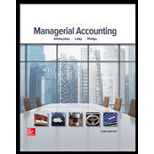
Concept explainers
Concept introduction:
Cost Volume Profit (CVP) Analysis:
The Cost Volume Profit analysis is the analysis of the relation between cost, volume, and profit of a product. It analyzes the cost and profits at the different level of production, in order to determine the breakeven point and required the level of sales to earn the desired profit.
Contribution margin means the margin that is left with the company after recovering variable cost out of revenue earned by selling smart phones. The formula for contribution margin is as follows:
Contribution margin = Sales - Variable cost.
Similarly contribution margin ratio = Contribution/sales
Breakeven Point:
The Breakeven point is the level of sales at which the net profit is nil. It can be explained as a situation where the business is generating a sale that is equal to the expenses incurred and hence no
Breakeven point (units) = Total Fixed Costs(Sales Price Per unit -Variable Cost per unit)
To calculate:
The required sales units to earn the desired profit
Want to see the full answer?
Check out a sample textbook solution
Chapter 6 Solutions
MANAGERIAL ACCOUNTING >C<
- Pacific Retail Store purchased merchandise inventory worth $8,500 on February 15, with payment terms of 2/10, n/30 (meaning a 2% discount if paid within 10 days, otherwise the full amount is due within 30 days). If Pacific pays the invoice on February 22, how much will they pay?arrow_forwardI am looking for help with this accounting question using proper accounting standards.arrow_forwardYou are a financial analyst at Beta Ltd., a company that is considering acquiring Alpha Ltd. You have been tasked to perform a discounted cash flow (DCF) valuation analysis in Excel to determine the value of the target company and advise on whether the acquisition would be financially beneficial. The following information is provided: 1. Alpha Ltd. revenues were Sh.12.5 million. This revenue is expected to grow at a constant annual growth rate of 7.5% over the next 5 years. 2. Alpha’s Ltd. gross profit margin is 75%. 3. The target company currently has Sh.8 million in debt and Sh. 3 million in equity. 4. Selling general, administration and other expenses is expected to be 45% of sales. 5. Depreciation is expected to be 2.5% of sales. 6. Net capital expenditures are expected to be 2.5% of net revenue annually. 7. Changes in net working capital are expected to amount to Sh.500,000, Sh.600,000, Sh.700,000,…arrow_forward
- Hanks Company estimates its manufacturing overhead to be $450,000 and its direct labor costs to be $300,000 for year 5. Hanks worked three jobs for the year. Job 5-1, which was sold during year 5, had actual direct labor costs of $90,000. Job 5-2, which was completed but not sold at the end of the year, had actual direct labor costs of $140,000. Job 5-3, which is still in work-in-process inventory, had actual direct labor costs of $80,000. The actual manufacturing overhead for year 5 was $470,000. Manufacturing overhead is applied on the basis of direct labor costs. a) How much overhead was applied to each job in year 5? b) What was the over-or underapplied manufacturing overhead for year 5?arrow_forwardGiven solution for General accounting question not use aiarrow_forwardHelp me question and accountingarrow_forward
- Please provide the accurate answer to this general accounting problem using valid techniques.arrow_forwardI need the correct answer to this financial accounting problem using the standard accounting approach.arrow_forwardI need assistance with this financial accounting question using appropriate principles.arrow_forward
- Ming Sporting Goods had a balance in the Accounts Receivable account of $780,000 at the beginning of the year and a balance of $820,000 at the end of the year. Net credit sales during the year amounted to $6,400,000. Required: What was the average collection period of the receivables in terms of days?arrow_forwardA company produces a single product. Variable production costs are $18.2 per unit, and variable selling and administrative expenses are $6.5 per unit. Fixed manufacturing overhead totals $72,000, and fixed selling and administration expenses total $63,000. Assuming a beginning inventory of zero, production of 7,500 units, and sales of 5,200 units, the dollar value of the ending inventory under variable costing would be_.arrow_forwardPlease provide the correct answer to this accounting problem using accurate calculations.arrow_forward
 Cornerstones of Financial AccountingAccountingISBN:9781337690881Author:Jay Rich, Jeff JonesPublisher:Cengage Learning
Cornerstones of Financial AccountingAccountingISBN:9781337690881Author:Jay Rich, Jeff JonesPublisher:Cengage Learning


